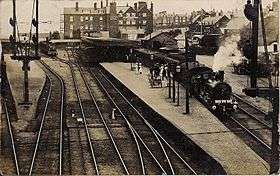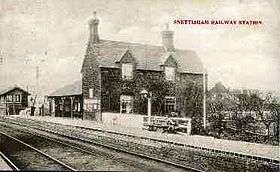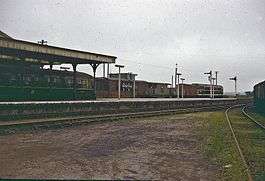Lynn and Hunstanton Railway
The Lynn and Hunstanton Railway was an English railway company that built a line between the two points. It was promoted locally and opened in 1862. It played a major part in developing Hunstanton as a seaside pleasure resort and residential community. The company was successful financially. The allied West Norfolk Junction Railway was built, connecting Heacham, just south of Hunstanton, to Wells-next-the-Sea, but this line did not attract much custom and was not a financial success. The two companies amalgamated in 1874 to form the Hunstanton and West Norfolk Railway, and in 1890 the company's railway system was sold to the larger Great Eastern Railway.
The Prince of Wales, later King Edward VII, acquired an estate at Sandringham, and Wolferton station became very much used by the Royal Family and by visiting heads of state. Hunstanton developed a thriving holiday trade, and day trip excursions also became very popular. However, after 1950 a decline set in, and the Wells line closed to passengers in 1952; the Hunstanton through trains to and from London were taken off in 1960 and further decline resulted in total closure in 1969.
Promotion and construction

An attempt had been made as early as 1846 to promote Hunstanton as a seaside resort, and by the mid 1850s there was a definite move by business people with an interest in the district to generate visits for seaside recreatonal purposes. The East Anglian Railway subsidised two omnibus services to the town from Lynn, but the town still had a population if under 500 in 1861.[1]
A railway connection (the northern part of the Lynn and Ely Railway) had reached King's Lynn, then known locally as Lynn, in 1846,[2] but Lynn was 16 miles away; a railway connection was essential to their objective. A Parliamentary Bill was presented for the 1861 session for a line connecting the town to Lynn and it passed without difficulty, gaining the Royal Assent on 1 August 1861. The Lynn and Hunstanton Railway was incorporated, with authorised capital of £60,000. The Hunstanton terminus was at New Hunstanton, an area south of the old centre, and where urban development was considered to be possible.[3][4][5]
The Engineer was John Sutherland Valentine; raising the subscription investments proceeded without difficulty, and the first sod was cut on 13 November 1861. Construction was easy as the terrain was relatively flat, and the line was completed in ten months within budget.[3]
Opening

The Board of Trade inspection, required for passenger operation, took place in September 1862, and was satisfactory. The line opened for traffic on 3 October 1862, worked from the outset by the Great Eastern Railway for 50% of receipts.[3][2][4][1]
The Times reported:
Railway Intelligence... Lynn and Hunstanton: This line was opened for traffic on Friday. The first train started at a little after noon, and conveyed the directors, contractors, and officers of the company, shareholders and others, to the number of about 150. A luncheon was served at the Hunstanton terminus. The line is 15 miles in length from the junction with the East Anglian division of the Great Eastern [Railway] at Gaywood [immediately north of King's Lynn], and its cost amounted altogether to only £80,000. The late Mr. L'Estrange, the proprietor of Hunstanton [Estate], sold the land for about 4 1⁄2 miles of the line at its agricultural value, and took the price in shares...
The Wolverton [Wolferton] station is on the estate of the Prince of Wales (through which the line runs for nearly three miles), and is to be enlarged at the expense and for the accommodation of his Royal Highness. The Hunstanton terminus is near the verge of the cliffs. The line is worked by the Great Eastern Railway Company.[6]
.jpg)
The Sandringham Estate had been purchased in February 1862 for the Prince of Wales, later King Edward VII.
The company was immediately successful; at a shareholders' meeting in August 1864, it was reported that receipts were £3,500, and the profit after expenses was £1,372. A dividend of 4.5% was declared; by 1865 dividends of 6% were being distributed.[3]
Extending to Wells

The success of the line led business interests to consider whether the North Norfolk coast, eastwards from Hunstanton, could profitably be opened up by a railway connection. This led to plans for a West Norfolk Junction Railway, which was to be nominally independent; it was to be a lightly constructed line acting as a feeder to the Lynn and Hunstanton Railway, possibly a tramway line running alongside public roads.
In the event a conventional railway was planned, and the West Norfolk Junction Railway obtained the Royal Assent on 23 June 1864: the line was to run from Heacham, the first station south of Hunstanton, to the terminus of the Wells and Fakenham Railway at Wells. It would be 18 miles in length, with authorised capital of £75,000; running powers were given to the new company to run trains to Hunstanton and Wells Harbour respectviely. The Great Eastern Railway subscribed £30,000 and agreed to work the line for 50% of gross receipts.[3][7]
Once again progress with construction was swift, and on 8 January 1866 the Prince and Princess of Wales had a semi-private journey on the line when they travelled to Holkham Hall, visiting the Earl of Leicester; this was several months before the official opening of the line.[3][7][1]
The necessary Board of Trade inspection took place but at first consent to opening was refused, due to shortcomings in the signalling arrangements. These were rectified and the line actually opened 17 August 1866.[3][2][7][4]

The route curved sharply north at Wells to use the existing Wells and Fakenham Railway station; that line had opened in 1857.[2] An additional platform was provided for the West Norfolk trains. A triangular junction was intended at both Heacham and Wells, but although a west to wet curve formation was made at Wells, no track was laid on it, and no work was done towards the Heacham curve. At Heacham therefore the line faced away from Hunstanton.[3][7]
There were generally four trains each way between Wells and Heacham, rising to five on Saturdays and market days. In the very earliest days passenger trains ran from Lynn to Wells via Hunstanton, passing Heacham twice; but sonn most services terminated at Heacham, but there was usually one through working to Hunstanton, which continued northwards after reversal at the junction. Goods services consisted of one return working between King's Lynn and Wells.[7][1]
The financial crisis in 1866 following the failure of the banking firm of Overend, Gurney and Company, and an outbreak of cattle plague in North Norfolk hit the income of the company badly in the first years: receipts amounted to £1,355 for the final quarter year of 1866, and no dividend was available. Because of the contrast with the financial success of the Lynn and Hunstanton line, this was a considerable disappointment. It was stated that the course of the line, which was some distance from the coast and the towns and villages situated on it, militated against usage of the line for goods and passenger purposes.[3]
Amalgamations

The West Norfolk Railway had always been allied with the Lynn and Hunstanton Railway, and the decision was taken to amalgamate the two concerns; this was ratified by Act of 8 June 1874. The title of the combined company was the Hunstanton and West Norfolk Railway.[5][1]
Notwithstanding the comparative success of the Lynn and Hunstanton main line, the independence of smaller railways became ever more fragile in the latter decades of the nineteenth cnetury, and on 1 July 1890 the Lynn and Hunstanton Railway was sold to the Great Eastern Railway for £160,000 in cash, supplemented by £5,000 for legal expenses.[3][1]
Growth from 1890
In the final years of the century, Hunstanton developed very considerably as a seaside holiday resort. This was not only for holiday stays, but many wealthy business people travelled to London for business and resided at Hunstanton. Golfing stays at Hunstanton also became popular; from 1905 there was a Sunday restaurant car express from London specifically aimed at golfers.[1]
As traffic developed, it was considered necessary to double the track over the southern part of the route; this was completed between King's Lynn and Wolferton in 1898.
The use of the Sandringham Estate by the Royal Family also increased in this period. The Royal trains reversed at King's Lynn and were operated by local engines and crews north of that point. At the London end they generally ran to St Pancras station, reached over the Tottenham and Hampstead Junction Railway line. Liverpool Street station was not favoured as entry of Royalty to the City of London required certain ceremonial procedures, which were not always expedient.[3] Between 1884 and 1911, 645 Royal Trains used Wolferton station.[2]
Ordinary express passenger trains also ran to St Pancras, or conveyed coaches for St Pancras that were slipped at Tottenham Hale or otherwise detached there.[7][5]
In the 1930s, Sunday excursions, particularly of Sunday schools, as well as long distance holiday trains, developed and became dominant.
The West Norfolk trains terminated at Heacham, not usually running through to Hunstanton. There was no proper runround facility at Wells, so after arrival and disembarkation of the passengers, the arriving engine propelled the coaches back up the gradient, and after shunting the engine out of the way, the coaches were gravitated down to the station.[3]
Pullman cars were run on some of the best trains from 1921, but they were not popular. A special day excursion train from London named the Eastern Belle was run from 1929. It ran to different seaside destinations from day to day, and typically visited Hunstanton every two weeks on a Tuesday.
In 1937 Hunstanton station was much enlarged. It already had four platforms but they were lengthened, and the general accommodation for handling passenger stock and locomotives was extended.
After World War II there was heavy holiday use of the line, especially on Sundays, when a one way system was operated: nearly all incoming trains ran in the morning and all outgoing trains in the afternoon and evening.[3] From 1949 a named train, The Fenman was introduced from Lverpool Street to Hunstanton. Heacham began to develop im its own right as a holiday destination.[1]
Decline after 1950
The poor passenger business on the West Norfolk line resulted in closure to passengers; the last passenger trains ran on Saturday 31 May 1952; however a special Pilgrims' passenger train ran from Kettering to Walsingham on 29 June 1952. Heavy flooding took place early in 1953, and the line was breached at Holkham. The decision was taken not to reinstate the line, as it was now open to goods traffic only; the stub from Heacham to Burnham was retained for a while for goods traffic, but it was fully closed after 28 December 1964. The same floods engulfed a train on the main line north of Heacham on 31 January 1953; the train was stranded for some time, and the line was not fully repaired until 23 February 1953.[1]
On the main line, diesel multiple units were introduced from 3 November 1958, and through trains from Liverpool Street to Hunstanton were withdrawn in November 1960, and the branch passenger service was operated as a shuttle from King's Lynn. Operation as a basic railway was brought in from 6 June 1966 in an attempt to contain costs.[1]
Hunstanton station was reduced to a single platform from 12 February 1967 and further reductions in operating facilities followed, when the one engine in steam system was instituted from Wolferton to Hunstanton on 5 March 1967, and King's Lynn to Wolferton was reduced to single track on 2 April 1967; from that date the entire line was worked as a single section; a no-signalman key token instrument was placed at Hunstanton.[3][1]
All freight had been withdrawn on the line in 1964.
Topography
Main line:
- Lynn; opened 27 October 1846; relocated 27 August 1871; renamed King's Lynn 1911;
- Salters Road Junction; connection to the Alexandra Dock branch;
- Gaywood Junction; former divergence of the Lynn and Fakenham Railway;
- Wootton; opened 3 October 1862; renamed North Wootton July 1869; closed 5 May 1969;
- Wolverton; opened 3 October 1862; renamed Wolferton 15 July 1863; closed 5 May 1969;
- Dersingham; opened 3 October 1862; closed 5 May 1969;
- Snettisham; opened 3 October 1862; closed 5 May 1969;
- Heacham; opened 3 October 1862; closed 5 May 1969;
- Hunstanton; opened 3 October 1862; closed 5 May 1969;
- Heacham; above;
- Sedgeford; opened 17 August 1866; closed 2 June 1952;
- Docking; opened 17 August 1866; closed 2 June 1952;
- Stanhoe; opened 17 August 1866; closed 2 June 1952;
- Burnham; opened 17 August 1866; renamed Burnham Market 1 June 1883; closed 2 June 1952;
- Holkham; opened 17 August 1866; closed 2 June 1952;
- Wells; opened by Wells and Fakenham Railway 1 December 1857; renamed Wells-on-Sea 1 July 1923; renamed Wells-next-the-Sea 1 January 1957; closed 5 October 1964.[9][8]
References
- 1 2 3 4 5 6 7 8 9 10 11 12 D I Gordon, A Regional History of the Railways of Great Britain: volume 5: the Eastern Counties, David & Charles, Newton Abbot, 1977, ISBN 0 7153 7431 1
- 1 2 3 4 5 Leslie Oppitz, Lost Railways of East Anglia, Countryside Books, Newbury, 1999, reprint 2000, ISBN 1 85306 595 1
- 1 2 3 4 5 6 7 8 9 10 11 12 13 14 15 Stanley C Jenkins, The Lynn and Hunstanton Railway and the West Norfolk Branch, The Oakwood Press, Usk, second edition 2011, ISBN 978 0 85361 713 6
- 1 2 3 Cecil J Allen, The Great Eastern Railway, Ian Allan Ltd, Shepperton, fifth edition, 1968
- 1 2 3 G W J Potter, The Great Eastern Railway in West Norfolk, in the Railway Magazine, June 1910
- ↑ The Times (newspaper), 6 October 1862
- 1 2 3 4 5 6 Stanley C Jenkins, The Wells-next-the-Sea Branch via Wymondham and Dereham, The Oakwood Press, Usk, second edition 2011, ISBN 978 0 85361 712 9
- 1 2 Neil Burgess, Norfolk's Lost Railways, Stenlake Publishing Ltd, Catrine, 2016, ISBN 978 1 84033 7556
- ↑ M E Quick, Railway Passenger Stations in England Scotland and Wales—A Chronology, The Railway and Canal Historical Society, 2002